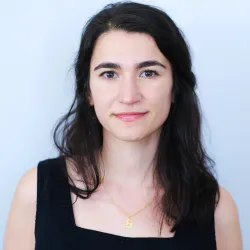
Recipient Information
Location
Nashville, Tennessee
Year of Award
2023
Grant or Fellowship
Southern Prize and State Fellowships
Grant Amount
$5,000
Beizar Aradini was born in Mardin, Kurdistan and immigrated with her family to Nashville, Tennessee in 1992. Her work unravels her family’s story as immigrants and examines cultural displacement through craft and fiber arts. Aradini's artwork has been exhibited nationally, including at the Frist Art Museum as part of the award-winning We Count: First-Time Voters exhibition. In 2021, she was awarded Best in Show in the Best of Tennessee Craft 2021 Biennial at the Tennessee State Museum. Aradini was also selected for an artist residency at Arquetopia International Artist Residency and completed an Andean Textile and Weaving workshop during her month-long stay in Urubamba, Peru, which was partially funded by a scholarship from Tennessee Craft.
Artist Statement
My artwork explores the liminal spaces and experiences of living in diaspora. I examine ideas and emotions of what home means for someone in displacement. I reflect on my family’s history of becoming refugees and then immigrating to the United States. There’s a shift that happens in this experience that has a profound imprint on our identities, memories, and narratives. To archive our history and preserve our stories and culture, I embroider old photographs that my family left behind while fleeing from war. Gradually, I’ve managed to collect these photos from all over the world. Some are collected from family friends displaced in other countries while others come from family members back in Kurdistan. Before I thread my needle, I manipulate and distort the photographs to resemble a memory. For those displaced, memories often become a home. Using these images, I portray to the viewer a sight that might not be familiar, but invite them to become a part of the narrative. I display an immigrant’s experience, one that comes from the dark consequences of imperialism and colonialism. By employing strong notions of family, I am trying to show how this is a collective experience that is often forgotten.